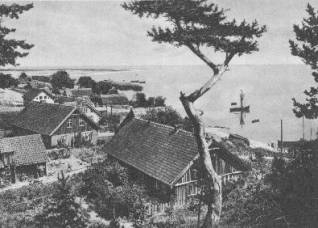Nidden - The phanomenon 
Der berühmte Italienblick
The Couranian spit
The Courland Spit is a narrow stripe of land separating the Courland Lagoon and the Baltic Sea. Earlier the spit had been almost entirely wooded, but deforestation caused great shifting dunes, that buried whole villages under the sand. Nidden as well had to be founded anew in 1870. The history of paving the dunes was long and successful, although the same dunes made the spit famous all over Europe as the "Sahara of the North". As most striking appeared a valley called "Valley of Silence", where no sound could be heard.
The residents mainly lived from fishing and the visitors in the summer. Since the end of the 19th century Nidden had been a famous and well known summer holiday place. Because of the special landscape many artists ended up at the Courland Spit and there are a lot of well known paintings of Nidden and the vicinity spread all over the world.
Colloquial languages on the Courland Spit from Nidden up to Memel were German and Curanian, an old Latvian dialect. On the lower part of the spit mainly Low German had been spoken. The Curanian of the spit could be mastered only by a few former residents today, it's a dying language.
Life in a fisher village hadn't been easy in those times. In 1936, for example, not all villages on the Courland Spit were supplied with electricity and running water, in Preil and Perwelk they still had to manage with paraffin lamps. On the barren sandy soil it was barely possible to cultivate something; even hay for the winter had to be taken from the mainland with boats. And fishing is always a dangerous business - not only in rain and storms.
Of course, Nidden as a summer holiday resort had to offer some comforts, so tere were hotels, boardinghouses and beds in more or less every fisher cottage. The visitors could take a tour in the fisher barge on the lagoon, there were pleasure boats from Memel, an artists' colony and famous guests like Thomas Mann who had a summer cottage in Nidden.Most important in the stories, the reports and holiday descriptions is the experience of the landscape and its specifics. The sea and the lagoon, the dunes and the high forest, migratory birds and elks - seem to throw a net of magic over every visitor who have to come back to the Curanian Lagoon or endure the longing.